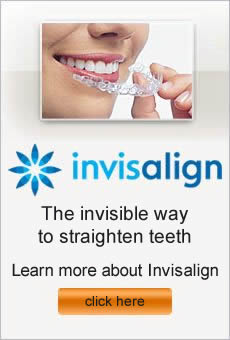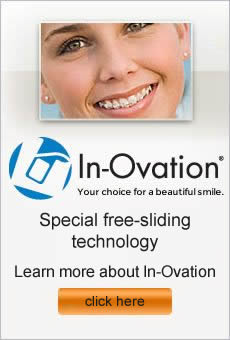Getting your braces off and revealing your brand new smile is an exciting prospect. In order to keep those perfectly aligned teeth, you will be required to utilize some form of orthodontic retainer.
When braces are removed, the teeth need to settle into the soft tissue and jawbone. A retainer helps keep your teeth from shifting to protect your orthodontic results over a lifetime. A custom-made retainer will hold the position of your teeth both immediately following your orthodontic treatment, and over time as aging naturally causes your teeth to shift.
Hawley retainers are the most common type of removable retainer. This retainer consists of a thick plastic body that covers the roof of your mouth or lies on the tongue side of your lower teeth. Clasps grasp selected teeth to anchor the retainer and “bow” wire across the front of your teeth. Hawley retainers are both removable and adjustable.
Another type of removable retainer is an Essex retainer. These clear plastic retainers are made with a cast to fit your teeth and are similar to Invisalign aligners. This type of retainer is less noticeable, but also more fragile and non-adjustable.
The success of any removable retainer depends largely on proper and consistent use as advised by your orthodontist. Your orthodontist may suggest a more permanent option. Fixed retainers are attached directly to the backside of your front teeth. They cannot be removed except by a dental professional. One advantage of fixed or “bonded” retainers is that you do not have to worry about them being lost, and they are always in place to do their job. Fixed retainers may be left in place for the remainder of your life.
Consult with Sherman Oaks CA orthodontist, Dr. Fotovat l to determine the most effective type of retainer for your orthodontic needs.
Choosing an orthodontist for you and your family is an important decision. Braces are a serious commitment, so you want to make sure you and your child are comfortable with the doctor and staff. Selecting the right orthodontic practice can make the overall experience and treatment better, as well as resulting in more beautiful smiles and improved self-esteem.
To begin your search for a qualified orthodontist, ask your family dentist, friends, co-workers and family for recommendations. Once you have identified several potential practices, you should schedule an initial consultation and come prepared with a list of questions to consider. The following is a list of questions you may want to include:
- What is the extent of your educational training in orthodontics?
How long have you been in practice?
- Are you a member of the American Association of Orthodontists and Board Certified by the American Board of Orthodontists?
- Who oversees treatment, the doctor or the assistants?
- Do you have extended hours before or after school and work?
- What type of treatment options do you offer?
- Do you offer alternatives to traditional metal braces, such as Invisalign?
- How long do you anticipate treatment to take from start to finish?
- What type of follow-up is included after braces are removed?
Can you provide references from past patients?
Because you will be visiting your orthodontist on a regular basis for follow-up visits, location is also an important consideration when choosing a practice. Proximity to the office can mean less time away from work or school. Finally, it is of vital importance that you select an orthodontic practice that makes you and your family feel welcome and comfortable. Taking the time to research thoroughly and select the best orthodontist will ensure a positive treatment experience and result in a lifetime of beautiful smiles.
You may be surprised to find out your young child should be evaluated for orthodontic treatment as early as the age of seven. The American Dental Association and the American Association of Orthodontics both recommend visiting a dental professional for an evaluation about the time their permanent teeth begin emerging. At this time, orthodontists can identify potential problems with erupting teeth and issues with jaw development and begin to develop a long-term plan for treatment.
Orthodontists usually suggest seeking treatment for problems such as overcrowding and bite issues before your child stops growing. Beginning the process early does not necessarily mean your child will be getting braces immediately, but it will allow your caregiver to correct problems that can make the orthodontic phase shorter and less complicated.
Many orthodontists are now recommending a two-step orthodontic treatment plan. The initial phase can begin at an earlier age, and sometimes utilizes a dental appliance rather than braces. The second phase involves the placement of traditional braces. This two-phase method of treatment can begin earlier than the traditional one-step plan unlike traditional braces that must wait until the majority of permanent teeth have emerged. A two-phase process is often shorter than treatment that did not begin with adjustments made with dental hardware.
Having your child’s teeth, bite, and jaw condition evaluated early could shave months or even years off their orthodontic treatment plan. Schedule a consultation with Burbank orthodontist, Dr. Fotovat today to find out more about how to ensure your child a lifetime of straight, beautiful smiles.
Have you recently had braces applied? If so, you’ll want to take care of them so they’ll do their work as quickly and efficiently as possible, but you’ll also want to take care of your teeth underneath, and that means developing or maintaining excellent oral hygiene habits. Hopefully you already have these habits in place, but getting braces means you’ll have to increase your vigilance toward oral hygiene and that you’ll have to get a little creative when it comes to hygiene steps that used to be routine, such as flossing.
When you have braces, food can get trapped around the brackets, bands, under the wires and beneath the gumline in ways that didn’t happen before the braces were in place. In order to keep your gums and teeth health so that you can enjoy a bright, beautiful, straight smile when the braces come off, you need to be certain that you’re cleaning your teeth in the best way possible.
Brushing becomes more complicated with braces. You must use a soft bristle toothbrush and clean first carefully between the bracket and the gumline. Angle your brush head downward toward the gum, allowing you to brush slightly beneath the gumline and removing food particles. Next, brush on top of the brackets, again angling your brush downward. Do this for the inner and outer arches of both your upper and lower teeth at least twice a day or after meals, but especially before bedtime.
In order to floss your teeth, you’ll need to thread the floss behind the wire and then floss normally, removing and rethreading the floss in the wire between each bracket. Run the floss along the body of the tooth, beneath the gumline, for each tooth. It’s recommend that you use a waterpik in order to remove the maximum amount of food, debris and bacteria that could lead to gum disease.
Take care of your oral hygiene while you are wearing braces, and when they finally come off, you’ll be left with the beautiful, healthy smile you’ve always dreamed of having.
Dr. Fotovat offers braces to patients in the Burbank CA area.
You have made the smart decision to improve your smile with Invisalign. Invisalign’s clear aligners make straightening your teeth both aesthetically appealing and easy to maintain. There are a few tips you can follow to ensure a successful treatment that results in a more perfect, new smile.
The most important step you can take is to find an excellent orthodontist with Invisalign experience. Your orthodontist should make time to answer all of your questions about treatment, and be vigilant and thorough with examinations and check-ups.
Once you start treatment, keep your aligners in place. For the first 48 hours your teeth will be adjusting to getting into new positions. They may be sore and sensitive, but this is a critical time for keeping the trays in as much as possible. Because the invisible aligner trays are removable, you may think it’s okay to remove them at any time. The success of your treatment depends on keeping the aligners in for the time recommended, usually at least 20 to 22 hours per day. Take them out to eat and to clean the trays, but otherwise, they should remain in your mouth.
Brush your teeth and aligner trays on a regular basis. Aligners can get plaque build-up just like your teeth, so it’s imperative that you keep them clean. The trays can be cleaned with either Invisalign’s tool kit, or a soft toothbrush and non-abrasive toothpaste. Invisalign trays should be removed from your mouth for cleaning.
By following these easy tips, you can help guarantee Invisalign will work to straighten your misaligned teeth and ultimately give you a beautiful new smile.
If you live in the Sherman Oaks CA and you are considering Invisalign, contact Dr. Fotovat’s orthodontics office today.
As you child has grown older, his or her baby teeth will begin to loosen and fall out. They will be replaced by permanent adult teeth. Adult teeth are larger than baby teeth, and as they begin to erupt, you may notice that your child’s smile is becoming crowded. If you think a visit to the orthodontist is in your future, you may be imagining what a life with braces will bring for your child.
The process for braces begins with an examination. The orthodontist will look at x-rays and will make a mold of the teeth. Some orthodontists are able to do this without messy, time-consuming trays by utilizing laser light and computers to create a 3D image of your child’s mouth in only a few minutes, a process that is vastly more comfortable for your child.
Application of the braces typically takes between one to two hours. Metal brackets or bands and wires are used to achieve the first stages of treatment. Because your child’s mouth will be open for a long time, it’s helpful to be certain that he or she is properly hydrated before application, and that a lip balm is used to protect dry, stretched lips from cracking. It can be useful to give your child a dose of an over-the-counter pain reliever that reduces inflammation, such as ibuprofen, prior to beginning application. This can help get ahead of any discomfort that your child will experience later that day.
Your child will probably experience some discomfort in the two to three days following application or wire adjustment. Have plenty of soft foods on hand and administer pain relieving medications as necessary. Help your child get plenty of rest so that he or she can have time to recover.
It’s important to ensure that your child is continuing to maintain good oral hygiene. Brushing and flossing have never been more important. Ask child orthodontist Dr. Fotovat if you live in the Sherman Oaks area about these and other questions you might have about how your child will feel with new braces.



